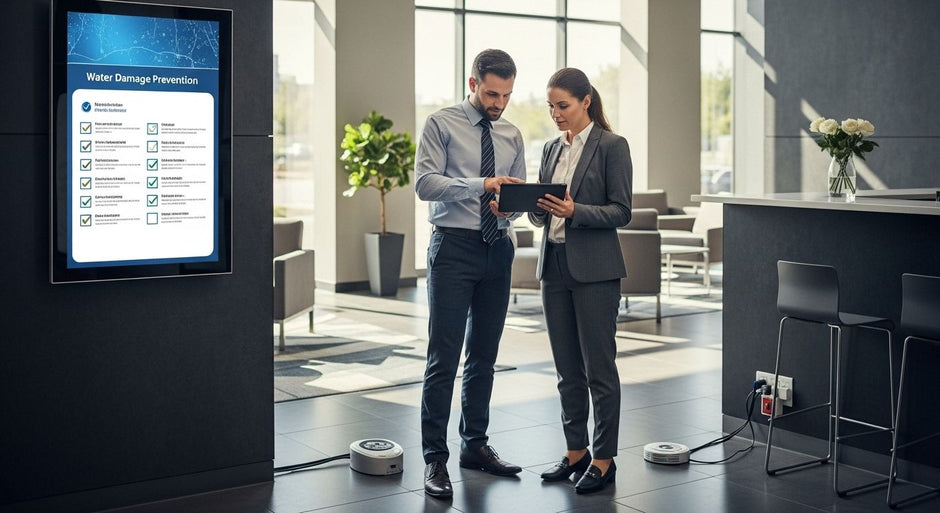Over 30 percent of workplace injuries are caused by slips, trips, and falls, often linked to worn or poorly maintained floor mats. Reliable mat maintenance not only protects employees but also helps businesses avoid unexpected costs and disruptions. A thorough approach to evaluating, maintaining, and replacing commercial floor mats sets the foundation for a safer, more efficient work environment while supporting long-term cost savings and compliance.
Table of Contents
- Step 1: Evaluate Existing Mats For Wear And Performance
- Step 2: Identify Key Factors Affecting Mat Life Cycle
- Step 3: Establish A Mat Inspection And Maintenance Schedule
- Step 4: Determine Replacement Timelines Based On Usage Data
- Step 5: Verify Results And Adjust Replacement Frequency
Quick Summary
| Key Point | Explanation |
|---|---|
| 1. Regular Evaluation is Essential | Periodic inspection uncovers mat degradation, ensuring safety and performance in the workplace. |
| 2. Material Quality Impacts Longevity | Choose mats based on composition to enhance durability, as some materials are more resilient than others. |
| 3. Establish Inspection Schedules | Create a routine to check mats weekly and monthly to maintain their effectiveness and prevent risks. |
| 4. Use Data for Replacement Timelines | Analyze wear and traffic data to determine optimal timings for mat replacements, ensuring efficiency. |
| 5. Adjust Strategies Based on Results | Continuously review and refine your mat management approach to adapt to changing conditions and findings. |
Step 1: Evaluate Existing Mats for Wear and Performance
Evaluating the condition of your commercial floor mats requires a systematic approach to assessing material integrity and performance. This critical process helps businesses prevent potential safety hazards and maintain workplace efficiency.
Begin your mat evaluation by conducting a comprehensive visual inspection. According to the Consumer Product Safety Commission, key indicators of mat degradation include surface cracking, uneven wear patterns, compression damage, and reduced cushioning properties. Check for signs like fraying edges, visible tears, discoloration, or areas where the mat material has become thin or compressed beyond its original resilience.
Physical testing is equally important. Press down on different sections of the mat to assess its cushioning and resilience. A high-quality industrial mat should maintain its shape and provide consistent support. The National Academies Press emphasizes evaluating materials under specific performance conditions, which means testing mats in their actual working environment to understand their true functional capacity.
Pay special attention to high traffic zones where mat wear tends to be most pronounced. Look for areas showing significant compression or material breakdown. When more than 30% of the mat surface shows substantial wear or has lost its original thickness, it is typically time to consider replacement. Worn mats not only look unprofessional but can also pose safety risks by reducing slip resistance and cushioning.
Warning: Never compromise on mat quality or safety. A degraded mat can lead to workplace accidents, increased employee fatigue, and potential liability issues. Regular evaluation is not just about maintaining appearances but protecting your workforce.
Ready to move forward? The next step involves making an informed decision about whether to repair or replace your existing mats based on your comprehensive evaluation.
Step 2: Identify Key Factors Affecting Mat Life Cycle
Understanding the factors that impact your commercial floor mats’ life cycle is crucial for making informed purchasing and maintenance decisions. This step will help you pinpoint the critical elements that determine how long your mats will remain functional and effective.
Material composition plays a pivotal role in mat longevity. According to the Washington State Department of Enterprise Services, key considerations include the mat’s material quality, construction method, and environmental certifications. Different materials respond differently to wear and tear. Rubber mats typically outlast fabric mats, while synthetic fibers might provide better resistance to moisture and chemical exposure.
Traffic volume and environmental conditions are significant life cycle determinants. Mats in high-traffic industrial settings will degrade faster than those in low-use areas. The Whole Building Design Guide emphasizes assessing sustainability and performance standards that account for specific workplace environments. Consider factors like foot traffic intensity, exposure to chemicals, temperature variations, and potential mechanical stress.
Additional critical factors include cleaning frequency, maintenance practices, and initial mat quality. Mats subjected to regular cleaning and proper care will naturally last longer. Pay attention to manufacturer specifications about recommended maintenance and expected life span. A high-quality mat might cost more initially but can prove more economical over time due to extended durability.

Warning: Ignoring these factors can lead to premature mat failure, increased safety risks, and unexpected replacement costs. Regular assessment helps you proactively manage your mat assets.
Ready to dive deeper? The next step involves calculating the total cost of ownership for your commercial floor mats and understanding their long-term economic impact.
Step 3: Establish a Mat Inspection and Maintenance Schedule
Creating a systematic approach to mat inspection and maintenance is crucial for maximizing the longevity and performance of your commercial floor mats. This step will help you develop a proactive strategy that prevents premature wear and ensures workplace safety.
According to the National Academies Press, establishing a consistent performance measurement schedule is essential for material maintenance. Develop a structured inspection routine that includes weekly visual assessments and monthly comprehensive evaluations. Your weekly check should focus on surface condition, visible damage, and immediate safety concerns. Monthly inspections will involve more detailed examination of mat integrity, including checking for compression, material breakdown, and potential slip hazards.
Design your maintenance schedule based on your specific workplace conditions. High traffic areas might require more frequent inspections perhaps every two weeks instead of monthly. Create a standardized inspection checklist that covers critical factors such as mat thickness, surface evenness, edge condition, and overall structural integrity.
When conducting inspections, use a systematic approach. Start at one corner of the mat and methodically work your way across the entire surface. Look for subtle signs of wear that might not be immediately apparent. Check for areas of uneven compression, color fading, material thinning, or loss of cushioning properties. Pay special attention to zones with highest foot traffic or exposure to potential damaging elements.
Warning: Inconsistent maintenance can lead to unexpected mat failure, which creates potential safety risks and unexpected replacement costs. Treat your mat maintenance schedule as a critical part of your workplace safety protocol.
Ready to take the next step? Develop a comprehensive tracking system to document your mat inspections and create a clear replacement strategy based on your findings.
Step 4: Determine Replacement Timelines Based on Usage Data
Transforming your mat inspection data into actionable replacement timelines requires a strategic approach that balances performance metrics with practical business considerations. This step will help you develop a data driven method for deciding when to replace your commercial floor mats.
According to the National Academies Press, quantifying performance metrics is crucial for determining optimal replacement intervals. Develop a tracking system that captures key usage indicators such as daily foot traffic volume, exposure to potential damaging substances, and observable wear patterns. Assign a numerical degradation score to your mats during each inspection that considers factors like material compression, surface integrity, and visual appearance.
The National Academies Press recommends establishing performance measurement standards that go beyond simple visual assessments. Create a comprehensive scoring system where mats receive point deductions based on specific wear characteristics. For instance assign point reductions for surface compression over 30%, visible tear percentage, color fading, or loss of cushioning effectiveness. When a mat reaches a predetermined threshold score perhaps 60 or 70 points out of an initial 100 it signals that replacement should be considered.
Consider developing different replacement timelines for mats in varying workplace zones. High traffic areas like entrances or production floors might require more frequent replacements compared to low traffic administrative spaces. Your replacement strategy should account for these variations by creating zone specific assessment protocols and potentially maintaining a rotating inventory of mats to minimize workplace disruption.

Warning: Relying solely on visual inspection can lead to overlooking subtle but critical mat degradation. Your data tracking system must be rigorous and consistent to ensure workplace safety and optimal mat performance.
Ready to move forward? The next step involves creating a budget and procurement strategy that aligns with your newly developed replacement timeline approach.
Step 5: Verify Results and Adjust Replacement Frequency
Validating and refining your mat replacement strategy is an ongoing process that requires careful analysis and continuous improvement. This step will help you transform your initial replacement plan into a dynamic and responsive system that adapts to your specific workplace conditions.
According to the National Academies Press, synthesizing performance measures is crucial for verifying and adjusting replacement frequencies. Conduct a quarterly comprehensive review of your mat performance data. Compare the actual wear patterns and degradation rates with your initial replacement predictions. Look for discrepancies between expected and observed mat performance across different workplace zones and identify trends that might require strategy modifications.
The National Academies Press emphasizes the importance of creating a flexible performance measurement framework. Develop a feedback loop that allows for continuous refinement of your replacement timeline. This might involve adjusting your scoring system, modifying inspection protocols, or creating zone specific replacement strategies based on empirical data. Pay close attention to mats in high stress areas and be prepared to modify your approach if certain zones demonstrate accelerated wear or unexpected durability.
Establish a cross functional team responsible for mat performance analysis. Include perspectives from facilities management, safety personnel, and operational teams to ensure a comprehensive evaluation. Create a standardized reporting template that tracks key performance indicators such as replacement frequency, total cost of mat maintenance, and observed safety impacts. This holistic approach will provide deeper insights into the effectiveness of your mat replacement strategy.
Warning: Treating your replacement strategy as a static document can lead to inefficient maintenance practices. Your approach must remain dynamic and responsive to changing workplace conditions.
Ready for the final step? Implement a comprehensive documentation system that captures your mat performance insights and supports ongoing strategic decision making.
Keep Your Workplace Safe with the Right Mat Replacement Plan
Understanding exactly when and how to replace your commercial floor mats is essential for maintaining safety and professionalism in your business environment. If you have noticed worn areas, reduced cushioning, or increased slip risks from your current mats, it is time to consider a mat upgrade. This guide highlights the importance of regular inspections and data-driven replacement timelines to avoid costly accidents and unexpected downtime.
Discover a wide selection of durable and high-performance mats designed to meet your unique business needs at Commercial Mats. Whether you need mats for heavy foot traffic or specialized anti-fatigue support your next reliable mat solution is just a few clicks away. Act now to protect your employees and reduce long-term maintenance expenses by visiting Mats4U.com. Explore options like Indoor Mats and the trusted Waterhog Mats collection built to last.
Don’t wait until mat failure creates hazards or interrupts your workflow. Find your perfect mat today and implement a solid mat replacement strategy for ongoing safety and value.
Frequently Asked Questions
How often should I evaluate my commercial mats for wear and tear?
Regularly evaluate your commercial mats at least once a month. Implement a visual inspection checklist that includes checking for surface cracking, fraying edges, and overall structural integrity to ensure workplace safety.
What signs indicate that my mats need to be replaced?
Look for significant wear indicators like surface compression, fraying edges, and reduced cushioning properties. If more than 30% of your mat shows noticeable damage, it’s time to consider replacing it to maintain safety and professionalism.
How can I create an effective mat inspection schedule?
Establish a routine where you perform weekly visual assessments and more comprehensive evaluations every month. Tailor your inspection frequency based on mat usage, with high-traffic areas requiring checks every two weeks to ensure they remain safe and functional.
What factors should I consider when determining mat replacement timelines?
Consider foot traffic volume, environmental conditions, and the mat’s material composition. Create a scoring system that evaluates usage data, which can help determine optimal replacement timelines based on specific performance metrics such as surface integrity and observable wear patterns.
How do I verify the effectiveness of my mat replacement strategy?
Conduct a quarterly review to compare the actual performance of your mats against your initial predictions. Adjust your replacement frequency based on observed wear patterns and any discrepancies to keep your maintenance approach responsive to changing conditions.
What maintenance practices can extend the life of my mats?
Implement regular cleaning and follow manufacturer maintenance guidelines to maximize mat longevity. Regular attention can reduce wear and enhance performance, possibly doubling the effective life of your mats in high-use areas.







